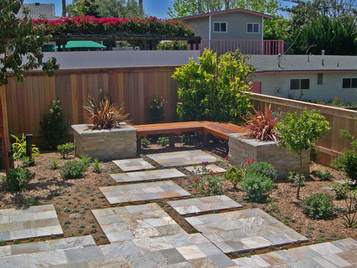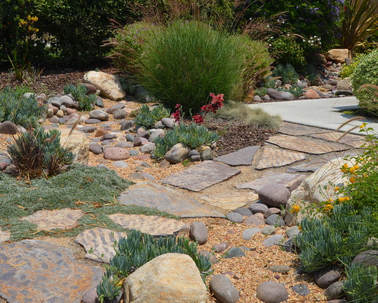steve harbour landscapes
Landscape Designer Steve Harbour Offers the best in affordable residential landscapes to San Diego County homeowners. .
 The walkway and sitting patio in this tiny Pacific Beach backyard were segmented, allowing more area for rain to penetrate into the soil. The walkway and sitting patio in this tiny Pacific Beach backyard were segmented, allowing more area for rain to penetrate into the soil. The second part of a two-part series. We discussed the watershed approach in the last article: How to Design Sustainable Patios and Walkways. But what exactly is the watershed approach? To understand this concept, let’s reverse the terms. We approach our outdoor landscapes as a natural watershed, which it is. The old concept of draining excess water directly to the gutter is archaic in California, replaced with the idea that we need to save this valuable resource and use it when we can, allowing it to sink into the soil and nourish plants rather than sending it to storm drains. It’s not only ethical, it’s practical and will save money on the water bill. How does the hardscape play a role with the watershed approach? As explained in Part One, hard or impermeable surfaces need to be minimized but that does not necessarily translate to less patio and walkway surface overall. We just need to use our design skills to allow areas for water to runoff and pool, then pick the right materials that are conducive to our goals. Here are a few tips.
0 Comments
 This landscape make-over in San Diegowas designed with a watershed approach. This landscape make-over in San Diegowas designed with a watershed approach. The move to designing sustainable landscapes in San Diego and elsewhere -- specifically patios, decks, and walkways -- does not mean we need to shrink these living spaces. Hardscape surfaces are as important as ever. Yet implementing the watershed approach - collecting water rather than sending it to storm drains - is a recent concept, creating the need for a variety of approaches when designing these areas. In other words, hardscapes are now less hard. In an eco-friendly garden, patios and walkways are designed to allow at least some water penetration beneath the surface, not simply to shed rain and irrigation to the closest storm drain. Here in San Diego and in landscape designs throughout the country, the trend toward more porous, less ‘hard’ hardscape materials often leads to a creative mix of materials blended together in the landscape. The monotone rock or concrete patio surface of yesteryear has given way to a more artful, elaborate mix of stone, tile, concrete, brick, gravel, sustainably-harvested wood or wood composite, and even steel. It's an artful blending that takes skill. The danger of designing with too few materials can make the landscape appear pedestrian, while the danger of using too many materials, without a careful eye to mix these materials, creates a scattered, unprofessional look. Selecting hardscape materials successfully – just as when mixing plants – has both its rewards and hazards. A huge area of one material, be it concrete, stone, or any other surface, loses impact. And too little of the same material may not have the desired look. Who is impressed at the sight of a rectangular sea of expensive flagstone, or for that matter a single band of tile across a driveway? The sea of flagstone is as boring as a commercial rock yard (at a huge expense) while the tile band in concrete appears engulfed by other features, a questionable choice that makes us wonder why anyone bothered at all. The flagstone patio would be more impressive by alternating materials, possibly colored concrete or brick, or by creating more angles or curves in the design. Some design themes — craftsman or Tuscan for example — have a rich history of combining various materials for design effect. By choosing a harmonious mix of materials in proper proportion, and by blending those materials together in pleasing shapes and patterns, the framework of the hardscape sets a superior tone for the gardens. See more on Sustainable Landscape Surfaces in Part 2 Sunny days and warm nights continue to ring in the New Year in San Diego, and outdoor kitchens, fireplaces, and fire pits remain on the front burners (pun intended) of most of my design clients’ wishes. As the economy continues to improve, people want to create outdoor rooms that can be enjoyed after the sun sets. Nearly all the landscape designs I have completed this year included at least one of these features.
A few tips to consider when designing an outdoor kitchen, fireplace, or fire pit:
Those are just a few of the more practical considerations to contemplate when designing and installing these outdoor features. With winter rapidly approaching, outdoor kitchens, fireplaces, and fire pits will be in increasing demand in San Diego landscapes. |
Categories |